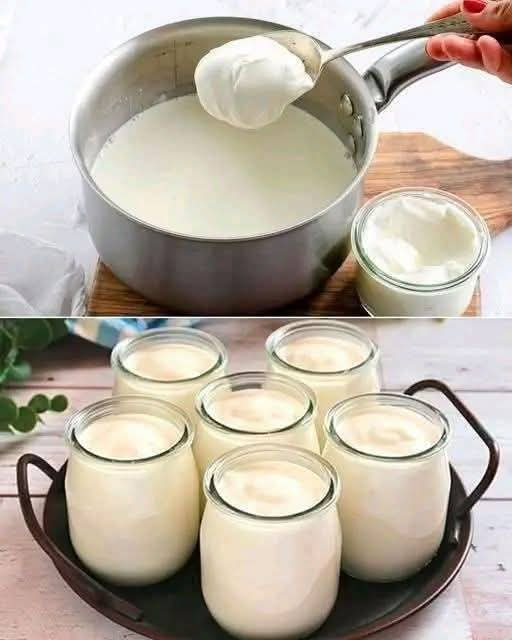Introduction
Making homemade yogurt with just two ingredients is simple and satisfying. This method allows you to enjoy fresh.
creamy yogurt at home without the need for fancy equipment or preservatives. All you need is milk and a bit of plain yogurt with live cultures to start the fermentation process.
With minimal effort and a bit of patience, you can have a large batch of yogurt ready to enjoy in just a few hours.
Homemade yogurt is versatile for snacks, smoothies, or as a base for parfaits, and you can customize it by adding your favorite toppings or flavors.
Ingredients
-1 liter of whole milk or your preferred milk (dairy or non-dairy)
-2 tablespoons of plain yogurt with live active cultures
Instructions
Start by heating the milk in a pot over medium heat. Stir occasionally to ensure the milk doesn’t scorch.
Heat the milk until it reaches about 180°F (82°C), just below boiling, and then remove it from the heat.
Allow the milk to cool to around 110°F (43°C). You can check this with a thermometer, or simply feel the milk with your finger; it should feel warm but not hot.
Once the milk has cooled, take 2 tablespoons of plain yogurt and mix it with a small amount of the warm milk in a separate bowl. Stir until the yogurt is fully dissolved into the milk.
Next, pour the yogurt mixture back into the pot with the rest of the warm milk and stir gently to combine.
Transfer the milk into a clean, covered container or jar. It’s important that the container is properly sealed to maintain the warmth inside during the fermentation process.
Place the container in a warm, undisturbed area to allow the yogurt to set. This could be in an oven with a light on, a yogurt maker.
or simply wrapped in towels to retain heat. Let it sit for 6-12 hours, depending on how thick and tangy you like your yogurt.
Once the yogurt has reached the desired consistency, place it in the fridge for at least 2 hours to cool and thicken further. The yogurt is now ready to serve or store.
How to Make
To begin making yogurt, heat the milk in a pot to around 180°F (82°C). This initial step helps to denature the proteins in the milk.
creating a smoother texture for your yogurt. Stir occasionally to ensure it doesn’t burn or stick to the bottom of the pot.
After heating, allow the milk to cool down to about 110°F (43°C). The milk should be warm enough to activate the cultures.
but not so hot that it kills them. Check by dipping a clean finger into the milk; it should feel pleasantly warm.
Add 2 tablespoons of plain yogurt with live cultures to a small bowl. Then, slowly mix in a few tablespoons of the warm milk.
This step ensures the yogurt dissolves evenly and avoids lumps in the final product.
Pour the yogurt-milk mixture back into the remaining milk in the pot, and stir gently to combine. Ensure the yogurt is evenly distributed throughout the milk for consistent fermentation.
Next, pour the milk into a clean container, making sure it is covered tightly to maintain warmth.
You can use a glass jar or bowl that has a lid, or simply cover it with a cloth or plastic wrap.
Place the container in a warm area, where the temperature remains steady between 100°F and 110°F (37°C – 43°C).
If you don’t have a yogurt maker, you can wrap the container in towels or place it in an oven with just the light on to keep the warmth consistent.
Let the yogurt set for 6-12 hours, depending on how thick and tart you prefer it. The longer it sits, the thicker and tangier it will become.
After the yogurt is done fermenting, place it in the fridge to cool and set for a few more hours before serving.
Tips
Make sure to use milk that is free of any added thickeners or stabilizers for the best results. Whole milk yields.
the creamiest yogurt, but you can experiment with other milk types depending on your preference.
The plain yogurt you use as a starter should have live active cultures. Check the label to ensure it contains probiotics, as this is what helps the milk ferment and turn into yogurt.
Keep the milk at the correct temperature during the fermentation process. Too hot or too cold can result in a failed.
batch, so try to maintain the temperature in the 100°F to 110°F range for best results.
If you don’t have a thermometer, you can test the temperature by dipping your finger in the milk; it should feel warm but not scalding.
To make the yogurt thicker, you can let it ferment for a longer time. If you prefer a thinner consistency, reduce the fermentation time slightly.
After the yogurt has finished setting, don’t stir it until it’s fully chilled. Stirring too early can break up the texture, so let it cool completely before mixing.
If you like flavored yogurt, add some fruit, honey, or vanilla extract to the yogurt after it has chilled. You can also add sweeteners to taste if you want a sweeter flavor.
Conclusion
Making yogurt at home with just two ingredients is a rewarding and easy process. You get fresh, creamy yogurt with no added preservatives or sugars, and it’s customizable to your taste.
With a little patience and the right conditions, you’ll have a large batch of homemade yogurt ready to enjoy anytime.
Plus, you can use a portion of it as a starter for your next batch, making the process even easier each time.
